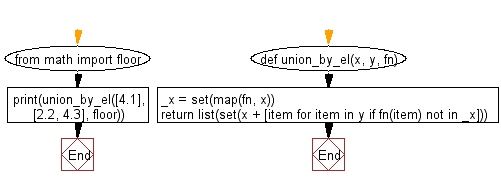Python: Return every element that exists in any of the two given lists once, after applying function to each element of both
Python List: Exercise - 228 with Solution
Write a Python program to get every element that exists in any of the two given lists once, after applying the provided function to each element of both.
- Create a set by applying fn to each element in x.
- Use a list comprehension in combination with fn on y to only keep values not contained in the previously created set, _x.
- Finally, create a set from the previous result and x and transform it into a list.
Sample Solution:
Python Code:
def union_by_el(x, y, fn):
_x = set(map(fn, x))
return list(set(x + [item for item in y if fn(item) not in _x]))
from math import floor
print(union_by_el([4.1], [2.2, 4.3], floor))
Sample Output:
[2.2, 4.1]
Flowchart:

Visualize Python code execution:
The following tool visualize what the computer is doing step-by-step as it executes the said program:
Python Code Editor:
Have another way to solve this solution? Contribute your code (and comments) through Disqus.
Previous: Write a Python program to get the symmetric difference between two lists, after applying the provided function to each list element of both.
Next: Write a Python program to find the index of the first element in the given list that satisfies the provided testing function.
What is the difficulty level of this exercise?
Test your Programming skills with w3resource's quiz.
Python: Tips of the Day
Find current directory and file's directory:
To get the full path to the directory a Python file is contained in, write this in that file:
import os dir_path = os.path.dirname(os.path.realpath(__file__))
(Note that the incantation above won't work if you've already used os.chdir() to change your current working directory, since the value of the __file__ constant is relative to the current working directory and is not changed by an os.chdir() call.)
To get the current working directory use
import os cwd = os.getcwd()
Documentation references for the modules, constants and functions used above:
- The os and os.path modules.
- The __file__ constant
- os.path.realpath(path) (returns "the canonical path of the specified filename, eliminating any symbolic links encountered in the path")
- os.path.dirname(path) (returns "the directory name of pathname path")
- os.getcwd() (returns "a string representing the current working directory")
- os.chdir(path) ("change the current working directory to path")
Ref: https://bit.ly/3fy0R6m
- New Content published on w3resource:
- HTML-CSS Practical: Exercises, Practice, Solution
- Java Regular Expression: Exercises, Practice, Solution
- Scala Programming Exercises, Practice, Solution
- Python Itertools exercises
- Python Numpy exercises
- Python GeoPy Package exercises
- Python Pandas exercises
- Python nltk exercises
- Python BeautifulSoup exercises
- Form Template
- Composer - PHP Package Manager
- PHPUnit - PHP Testing
- Laravel - PHP Framework
- Angular - JavaScript Framework
- Vue - JavaScript Framework
- Jest - JavaScript Testing Framework
